Meat and Seafood cuisine of Australia
VerifiedAdded on 2023/06/10
|12
|2779
|358
AI Summary
This article discusses the history and evolution of meat and seafood cuisine in Australia. It covers specific dishes, changes in serving style, and current restaurant menus. It also explores food allergens related to meat and seafood and measures to minimize allergic incidents. The subject is Hospitality, and the course code is not mentioned. The course name and college/university are not mentioned either.
Contribute Materials
Your contribution can guide someone’s learning journey. Share your
documents today.
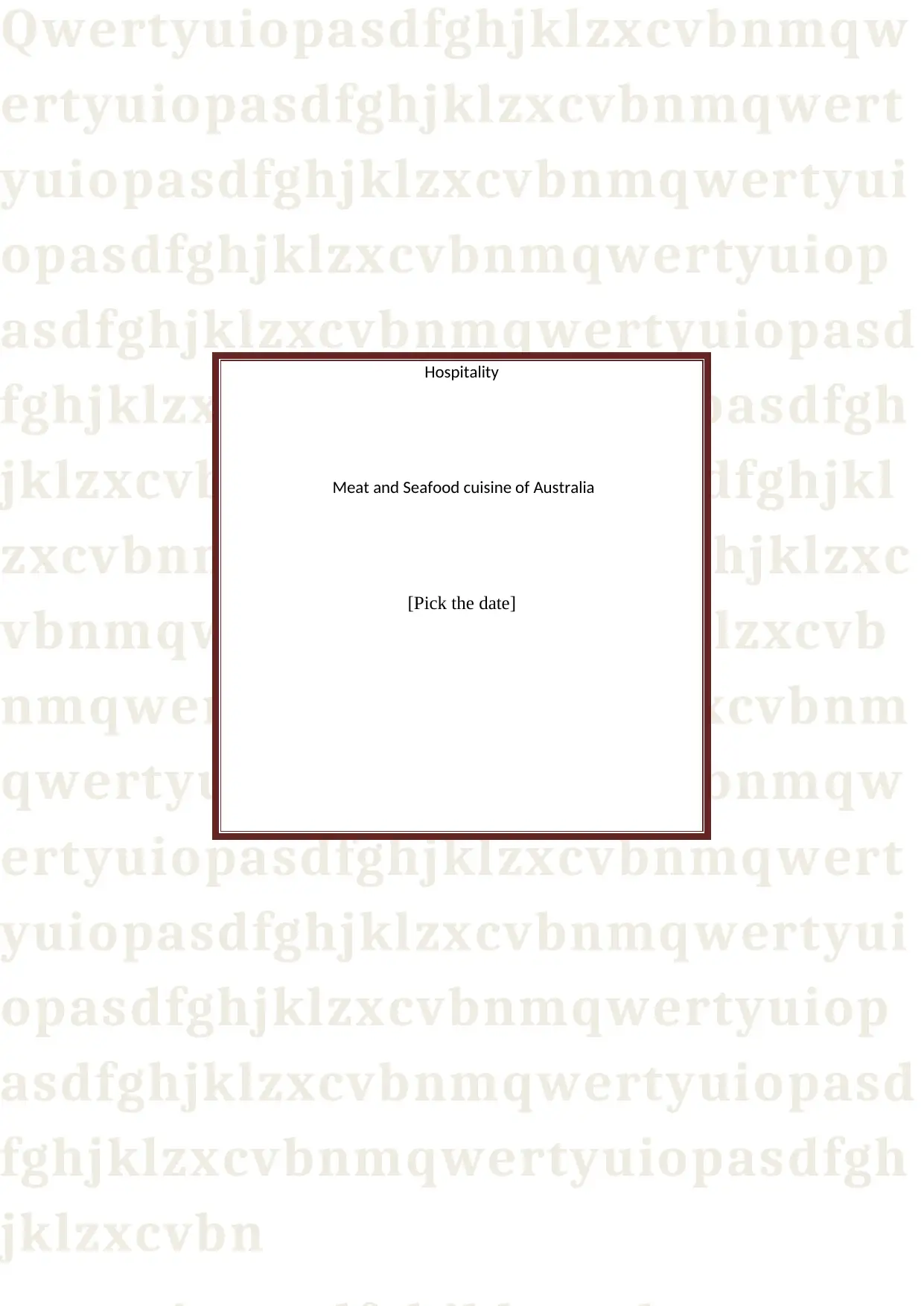
Qwertyuiopasdfghjklzxcvbnmqw
ertyuiopasdfghjklzxcvbnmqwert
yuiopasdfghjklzxcvbnmqwertyui
opasdfghjklzxcvbnmqwertyuiop
asdfghjklzxcvbnmqwertyuiopasd
fghjklzxcvbnmqwertyuiopasdfgh
jklzxcvbnmqwertyuiopasdfghjkl
zxcvbnmqwertyuiopasdfghjklzxc
vbnmqwertyuiopasdfghjklzxcvb
nmqwertyuiopasdfghjklzxcvbnm
qwertyuiopasdfghjklzxcvbnmqw
ertyuiopasdfghjklzxcvbnmqwert
yuiopasdfghjklzxcvbnmqwertyui
opasdfghjklzxcvbnmqwertyuiop
asdfghjklzxcvbnmqwertyuiopasd
fghjklzxcvbnmqwertyuiopasdfgh
jklzxcvbn
Hospitality
Meat and Seafood cuisine of Australia
[Pick the date]
ertyuiopasdfghjklzxcvbnmqwert
yuiopasdfghjklzxcvbnmqwertyui
opasdfghjklzxcvbnmqwertyuiop
asdfghjklzxcvbnmqwertyuiopasd
fghjklzxcvbnmqwertyuiopasdfgh
jklzxcvbnmqwertyuiopasdfghjkl
zxcvbnmqwertyuiopasdfghjklzxc
vbnmqwertyuiopasdfghjklzxcvb
nmqwertyuiopasdfghjklzxcvbnm
qwertyuiopasdfghjklzxcvbnmqw
ertyuiopasdfghjklzxcvbnmqwert
yuiopasdfghjklzxcvbnmqwertyui
opasdfghjklzxcvbnmqwertyuiop
asdfghjklzxcvbnmqwertyuiopasd
fghjklzxcvbnmqwertyuiopasdfgh
jklzxcvbn
Hospitality
Meat and Seafood cuisine of Australia
[Pick the date]
Secure Best Marks with AI Grader
Need help grading? Try our AI Grader for instant feedback on your assignments.
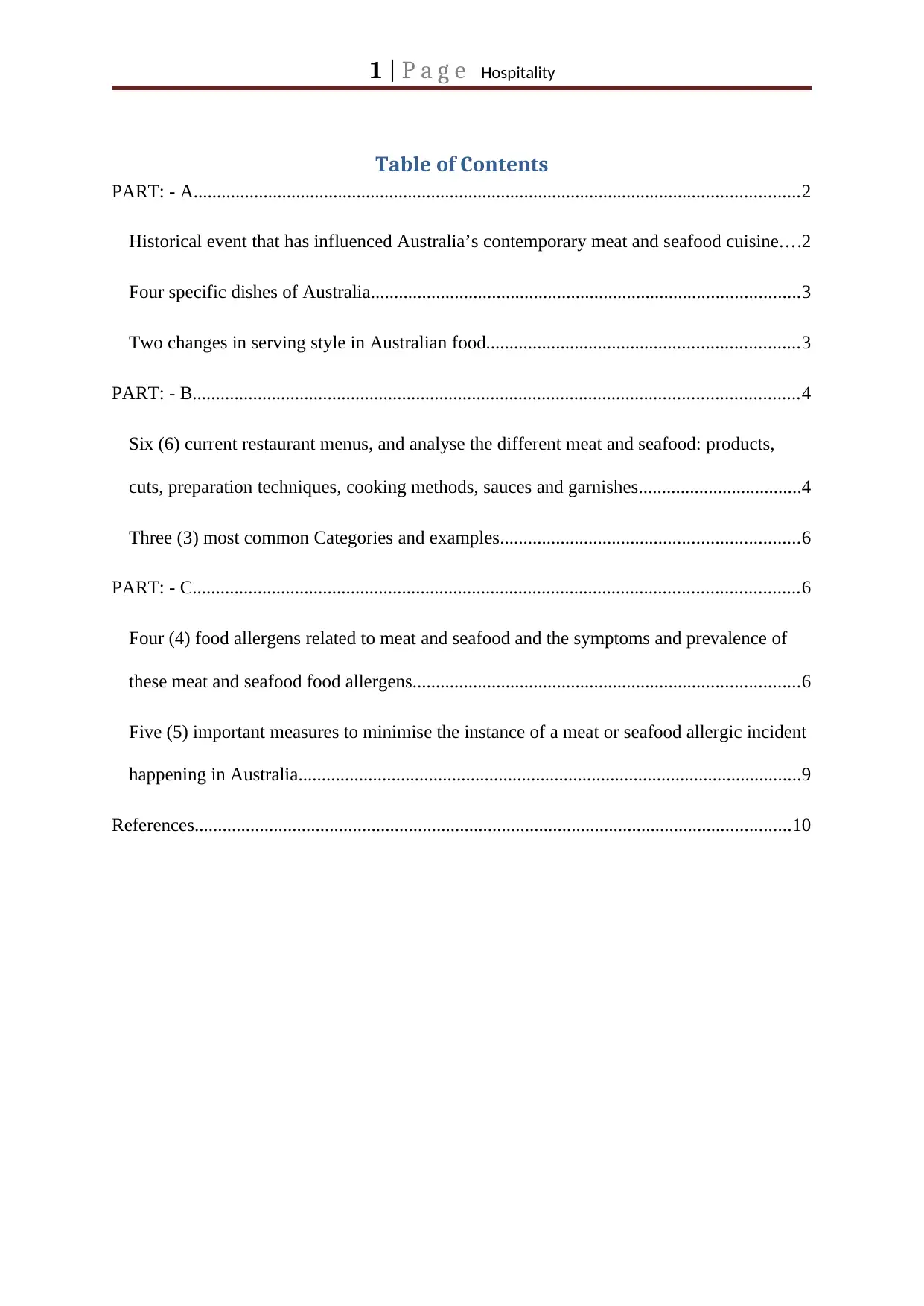
1 | P a g e Hospitality
Table of Contents
PART: - A..................................................................................................................................2
Historical event that has influenced Australia’s contemporary meat and seafood cuisine....2
Four specific dishes of Australia............................................................................................3
Two changes in serving style in Australian food...................................................................3
PART: - B..................................................................................................................................4
Six (6) current restaurant menus, and analyse the different meat and seafood: products,
cuts, preparation techniques, cooking methods, sauces and garnishes...................................4
Three (3) most common Categories and examples................................................................6
PART: - C..................................................................................................................................6
Four (4) food allergens related to meat and seafood and the symptoms and prevalence of
these meat and seafood food allergens...................................................................................6
Five (5) important measures to minimise the instance of a meat or seafood allergic incident
happening in Australia............................................................................................................9
References................................................................................................................................10
Table of Contents
PART: - A..................................................................................................................................2
Historical event that has influenced Australia’s contemporary meat and seafood cuisine....2
Four specific dishes of Australia............................................................................................3
Two changes in serving style in Australian food...................................................................3
PART: - B..................................................................................................................................4
Six (6) current restaurant menus, and analyse the different meat and seafood: products,
cuts, preparation techniques, cooking methods, sauces and garnishes...................................4
Three (3) most common Categories and examples................................................................6
PART: - C..................................................................................................................................6
Four (4) food allergens related to meat and seafood and the symptoms and prevalence of
these meat and seafood food allergens...................................................................................6
Five (5) important measures to minimise the instance of a meat or seafood allergic incident
happening in Australia............................................................................................................9
References................................................................................................................................10
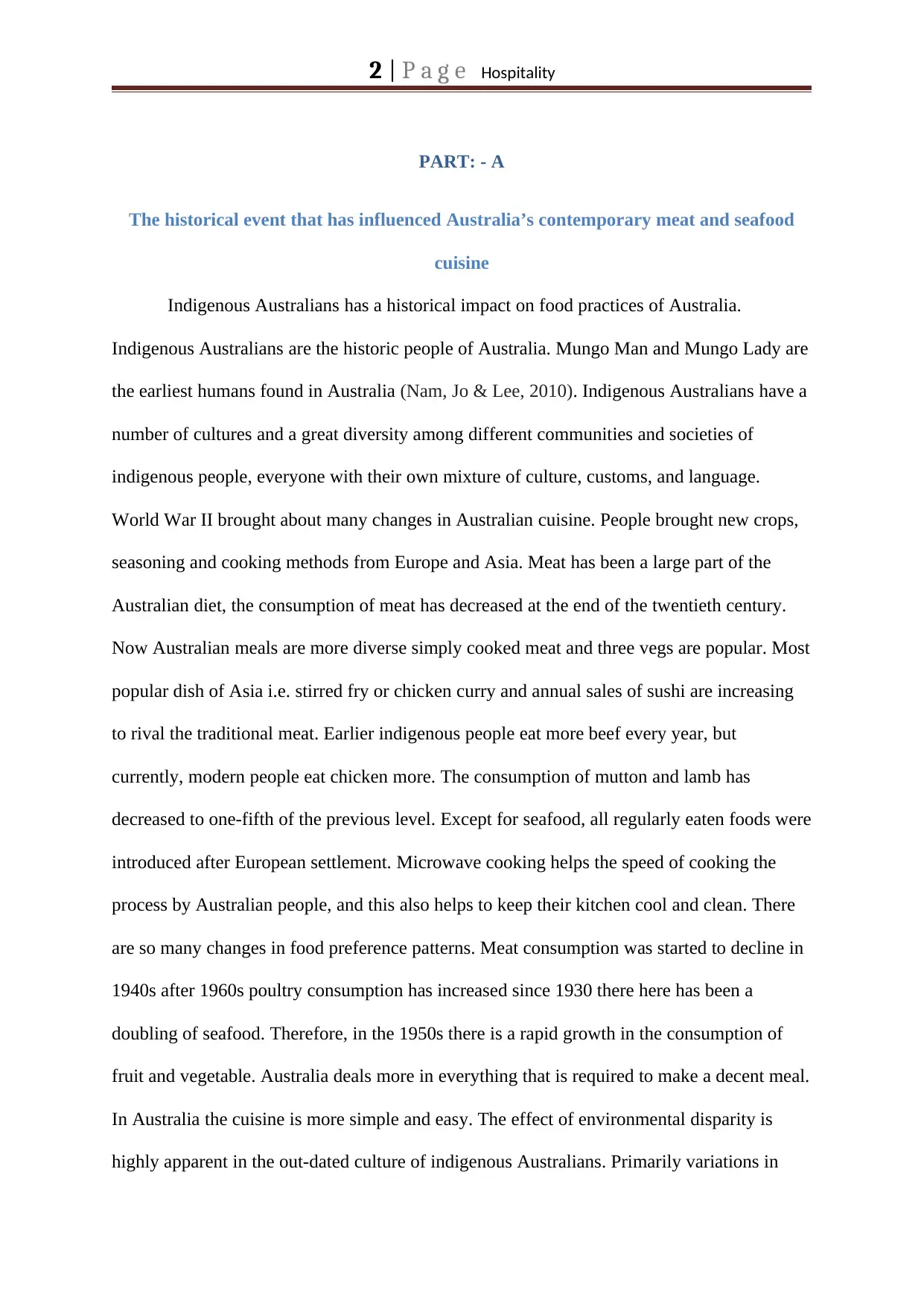
2 | P a g e Hospitality
PART: - A
The historical event that has influenced Australia’s contemporary meat and seafood
cuisine
Indigenous Australians has a historical impact on food practices of Australia.
Indigenous Australians are the historic people of Australia. Mungo Man and Mungo Lady are
the earliest humans found in Australia (Nam, Jo & Lee, 2010). Indigenous Australians have a
number of cultures and a great diversity among different communities and societies of
indigenous people, everyone with their own mixture of culture, customs, and language.
World War II brought about many changes in Australian cuisine. People brought new crops,
seasoning and cooking methods from Europe and Asia. Meat has been a large part of the
Australian diet, the consumption of meat has decreased at the end of the twentieth century.
Now Australian meals are more diverse simply cooked meat and three vegs are popular. Most
popular dish of Asia i.e. stirred fry or chicken curry and annual sales of sushi are increasing
to rival the traditional meat. Earlier indigenous people eat more beef every year, but
currently, modern people eat chicken more. The consumption of mutton and lamb has
decreased to one-fifth of the previous level. Except for seafood, all regularly eaten foods were
introduced after European settlement. Microwave cooking helps the speed of cooking the
process by Australian people, and this also helps to keep their kitchen cool and clean. There
are so many changes in food preference patterns. Meat consumption was started to decline in
1940s after 1960s poultry consumption has increased since 1930 there here has been a
doubling of seafood. Therefore, in the 1950s there is a rapid growth in the consumption of
fruit and vegetable. Australia deals more in everything that is required to make a decent meal.
In Australia the cuisine is more simple and easy. The effect of environmental disparity is
highly apparent in the out-dated culture of indigenous Australians. Primarily variations in
PART: - A
The historical event that has influenced Australia’s contemporary meat and seafood
cuisine
Indigenous Australians has a historical impact on food practices of Australia.
Indigenous Australians are the historic people of Australia. Mungo Man and Mungo Lady are
the earliest humans found in Australia (Nam, Jo & Lee, 2010). Indigenous Australians have a
number of cultures and a great diversity among different communities and societies of
indigenous people, everyone with their own mixture of culture, customs, and language.
World War II brought about many changes in Australian cuisine. People brought new crops,
seasoning and cooking methods from Europe and Asia. Meat has been a large part of the
Australian diet, the consumption of meat has decreased at the end of the twentieth century.
Now Australian meals are more diverse simply cooked meat and three vegs are popular. Most
popular dish of Asia i.e. stirred fry or chicken curry and annual sales of sushi are increasing
to rival the traditional meat. Earlier indigenous people eat more beef every year, but
currently, modern people eat chicken more. The consumption of mutton and lamb has
decreased to one-fifth of the previous level. Except for seafood, all regularly eaten foods were
introduced after European settlement. Microwave cooking helps the speed of cooking the
process by Australian people, and this also helps to keep their kitchen cool and clean. There
are so many changes in food preference patterns. Meat consumption was started to decline in
1940s after 1960s poultry consumption has increased since 1930 there here has been a
doubling of seafood. Therefore, in the 1950s there is a rapid growth in the consumption of
fruit and vegetable. Australia deals more in everything that is required to make a decent meal.
In Australia the cuisine is more simple and easy. The effect of environmental disparity is
highly apparent in the out-dated culture of indigenous Australians. Primarily variations in

3 | P a g e Hospitality
climate are the most significant factor of change. Due to less rainfall in Australia can cause a
problem in water quality and availability (Simoons, 2014).
Four specific dishes of Australia
1. John Dory Fillets: - In Australia, John Dory is a popular fish variety cuisine. It is
commonly found in water including Sydney Harbour. Maltreated and deep-fried and
presented with chips, or it is cooked in a pan with herbal oil served with crushed
potato with salad, this is handy, and meat fish are the most popular food in Australia.
2. Barbecued snags: - Australia is famous for barbecue. Australian snags are the heart
of people living there from the traditional chicken or grumble, to those flavored with
basils and seasonings from all across the world. The snag is something disheveled in
roll or a piece of bread covered with sauce and served with some cooked onion on top
with potatoes on the side (Schösler, De Boer & Boersema, 2012).
3. Prawn Cocktail: - Traditional seafood appetizer is a Prawn Cocktail. This is prepared
up of bombed prawns with dressing by tomato and mayonnaise, and then it is
presented in a glass or many times served in a lettuce leaf.
4. Sausage rolls: - Sausage rolls are draped in pie and oven baked. Australians eat these
rolls as their lunch. Australia like the taste of good sausage rolls. Cooking influences
from around the world to create exclusive taste involvements and a actual Australian
food.
Two changes in serving style in Australian food
1. In 1950s meat was always the main meal for Australians for dinner. Whether meat is
served as a hearty sausage, beef, lamb chops or mixed grill. This was a weekly ritual
for many Australians during that time. Families would join each other at the dining
table and everyone will eat roast lamb or beef. Now things are much more different. A
climate are the most significant factor of change. Due to less rainfall in Australia can cause a
problem in water quality and availability (Simoons, 2014).
Four specific dishes of Australia
1. John Dory Fillets: - In Australia, John Dory is a popular fish variety cuisine. It is
commonly found in water including Sydney Harbour. Maltreated and deep-fried and
presented with chips, or it is cooked in a pan with herbal oil served with crushed
potato with salad, this is handy, and meat fish are the most popular food in Australia.
2. Barbecued snags: - Australia is famous for barbecue. Australian snags are the heart
of people living there from the traditional chicken or grumble, to those flavored with
basils and seasonings from all across the world. The snag is something disheveled in
roll or a piece of bread covered with sauce and served with some cooked onion on top
with potatoes on the side (Schösler, De Boer & Boersema, 2012).
3. Prawn Cocktail: - Traditional seafood appetizer is a Prawn Cocktail. This is prepared
up of bombed prawns with dressing by tomato and mayonnaise, and then it is
presented in a glass or many times served in a lettuce leaf.
4. Sausage rolls: - Sausage rolls are draped in pie and oven baked. Australians eat these
rolls as their lunch. Australia like the taste of good sausage rolls. Cooking influences
from around the world to create exclusive taste involvements and a actual Australian
food.
Two changes in serving style in Australian food
1. In 1950s meat was always the main meal for Australians for dinner. Whether meat is
served as a hearty sausage, beef, lamb chops or mixed grill. This was a weekly ritual
for many Australians during that time. Families would join each other at the dining
table and everyone will eat roast lamb or beef. Now things are much more different. A
Paraphrase This Document
Need a fresh take? Get an instant paraphrase of this document with our AI Paraphraser
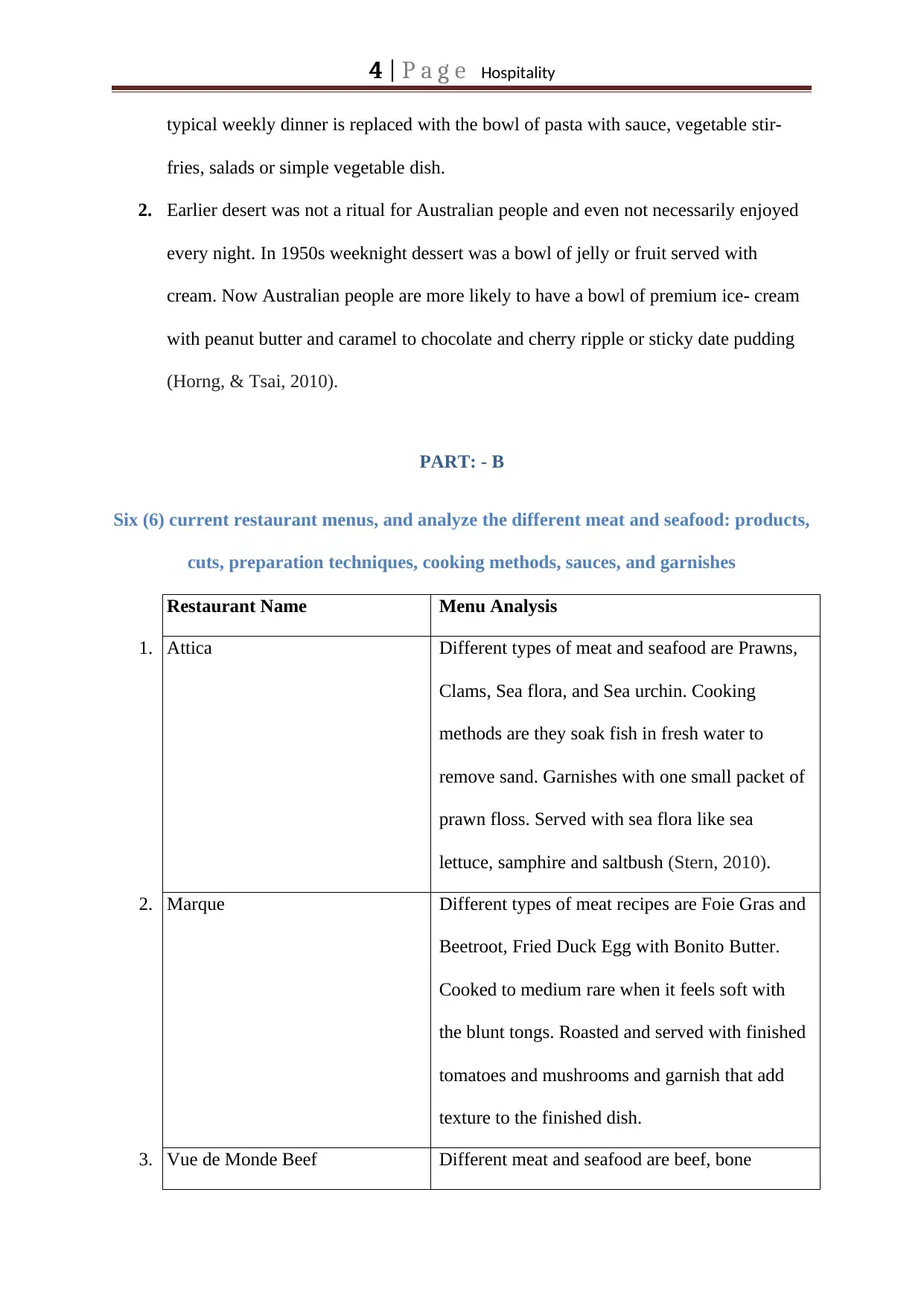
4 | P a g e Hospitality
typical weekly dinner is replaced with the bowl of pasta with sauce, vegetable stir-
fries, salads or simple vegetable dish.
2. Earlier desert was not a ritual for Australian people and even not necessarily enjoyed
every night. In 1950s weeknight dessert was a bowl of jelly or fruit served with
cream. Now Australian people are more likely to have a bowl of premium ice- cream
with peanut butter and caramel to chocolate and cherry ripple or sticky date pudding
(Horng, & Tsai, 2010).
PART: - B
Six (6) current restaurant menus, and analyze the different meat and seafood: products,
cuts, preparation techniques, cooking methods, sauces, and garnishes
Restaurant Name Menu Analysis
1. Attica Different types of meat and seafood are Prawns,
Clams, Sea flora, and Sea urchin. Cooking
methods are they soak fish in fresh water to
remove sand. Garnishes with one small packet of
prawn floss. Served with sea flora like sea
lettuce, samphire and saltbush (Stern, 2010).
2. Marque Different types of meat recipes are Foie Gras and
Beetroot, Fried Duck Egg with Bonito Butter.
Cooked to medium rare when it feels soft with
the blunt tongs. Roasted and served with finished
tomatoes and mushrooms and garnish that add
texture to the finished dish.
3. Vue de Monde Beef Different meat and seafood are beef, bone
typical weekly dinner is replaced with the bowl of pasta with sauce, vegetable stir-
fries, salads or simple vegetable dish.
2. Earlier desert was not a ritual for Australian people and even not necessarily enjoyed
every night. In 1950s weeknight dessert was a bowl of jelly or fruit served with
cream. Now Australian people are more likely to have a bowl of premium ice- cream
with peanut butter and caramel to chocolate and cherry ripple or sticky date pudding
(Horng, & Tsai, 2010).
PART: - B
Six (6) current restaurant menus, and analyze the different meat and seafood: products,
cuts, preparation techniques, cooking methods, sauces, and garnishes
Restaurant Name Menu Analysis
1. Attica Different types of meat and seafood are Prawns,
Clams, Sea flora, and Sea urchin. Cooking
methods are they soak fish in fresh water to
remove sand. Garnishes with one small packet of
prawn floss. Served with sea flora like sea
lettuce, samphire and saltbush (Stern, 2010).
2. Marque Different types of meat recipes are Foie Gras and
Beetroot, Fried Duck Egg with Bonito Butter.
Cooked to medium rare when it feels soft with
the blunt tongs. Roasted and served with finished
tomatoes and mushrooms and garnish that add
texture to the finished dish.
3. Vue de Monde Beef Different meat and seafood are beef, bone
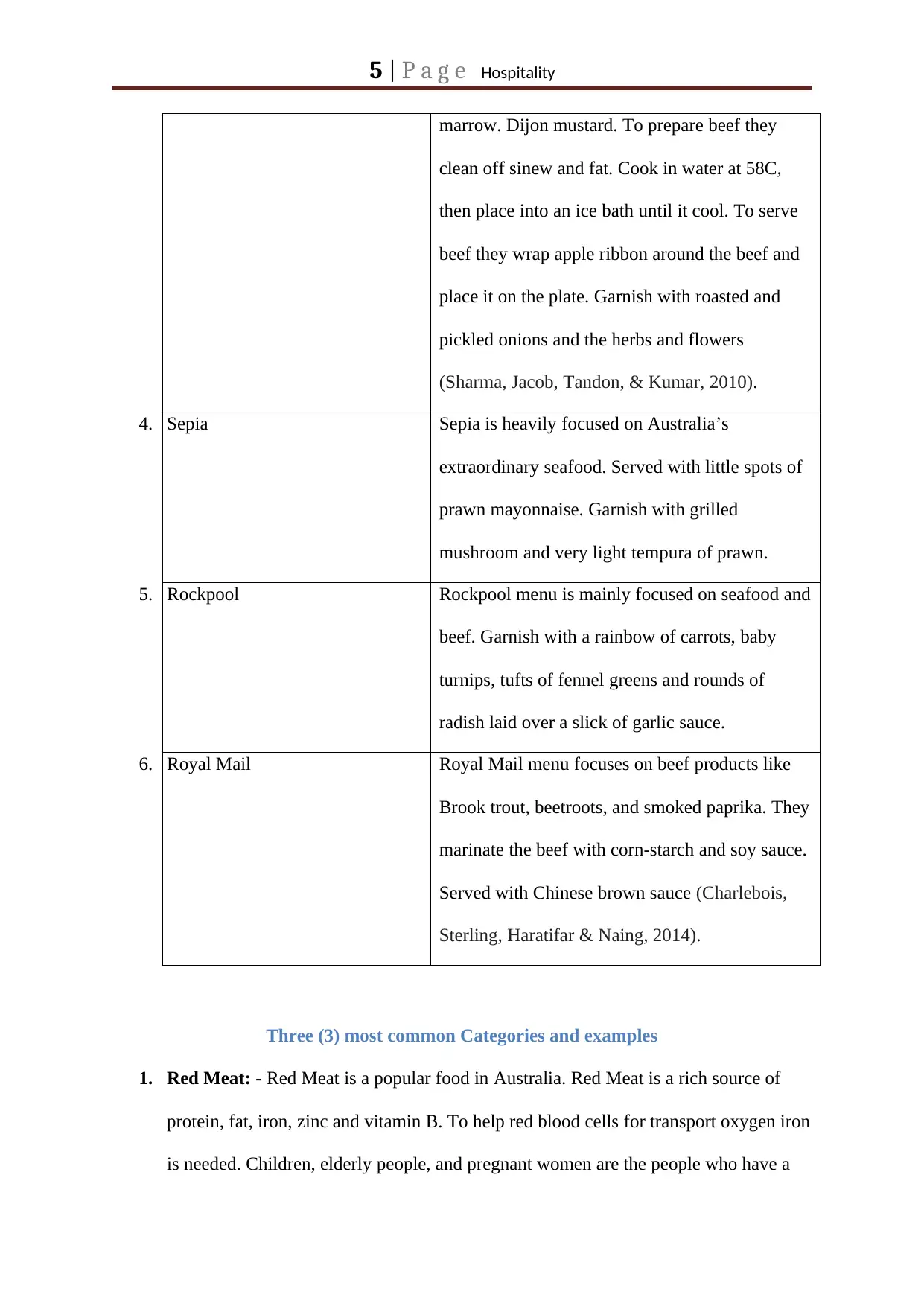
5 | P a g e Hospitality
marrow. Dijon mustard. To prepare beef they
clean off sinew and fat. Cook in water at 58C,
then place into an ice bath until it cool. To serve
beef they wrap apple ribbon around the beef and
place it on the plate. Garnish with roasted and
pickled onions and the herbs and flowers
(Sharma, Jacob, Tandon, & Kumar, 2010).
4. Sepia Sepia is heavily focused on Australia’s
extraordinary seafood. Served with little spots of
prawn mayonnaise. Garnish with grilled
mushroom and very light tempura of prawn.
5. Rockpool Rockpool menu is mainly focused on seafood and
beef. Garnish with a rainbow of carrots, baby
turnips, tufts of fennel greens and rounds of
radish laid over a slick of garlic sauce.
6. Royal Mail Royal Mail menu focuses on beef products like
Brook trout, beetroots, and smoked paprika. They
marinate the beef with corn-starch and soy sauce.
Served with Chinese brown sauce (Charlebois,
Sterling, Haratifar & Naing, 2014).
Three (3) most common Categories and examples
1. Red Meat: - Red Meat is a popular food in Australia. Red Meat is a rich source of
protein, fat, iron, zinc and vitamin B. To help red blood cells for transport oxygen iron
is needed. Children, elderly people, and pregnant women are the people who have a
marrow. Dijon mustard. To prepare beef they
clean off sinew and fat. Cook in water at 58C,
then place into an ice bath until it cool. To serve
beef they wrap apple ribbon around the beef and
place it on the plate. Garnish with roasted and
pickled onions and the herbs and flowers
(Sharma, Jacob, Tandon, & Kumar, 2010).
4. Sepia Sepia is heavily focused on Australia’s
extraordinary seafood. Served with little spots of
prawn mayonnaise. Garnish with grilled
mushroom and very light tempura of prawn.
5. Rockpool Rockpool menu is mainly focused on seafood and
beef. Garnish with a rainbow of carrots, baby
turnips, tufts of fennel greens and rounds of
radish laid over a slick of garlic sauce.
6. Royal Mail Royal Mail menu focuses on beef products like
Brook trout, beetroots, and smoked paprika. They
marinate the beef with corn-starch and soy sauce.
Served with Chinese brown sauce (Charlebois,
Sterling, Haratifar & Naing, 2014).
Three (3) most common Categories and examples
1. Red Meat: - Red Meat is a popular food in Australia. Red Meat is a rich source of
protein, fat, iron, zinc and vitamin B. To help red blood cells for transport oxygen iron
is needed. Children, elderly people, and pregnant women are the people who have a

6 | P a g e Hospitality
deficiency of iron. The strong immune system is build up and for DNA synthesis Zinc
is needed. Example of Red Meat is Pork, Ham, Lamb, Beef, etc.
2. White Meat: - White meat is pale in color before and after cooking. Poultry meat is
the most common kind of white meat. Poultry white meat is prepared up with muscle
fibers, while red or dark meat is prepared up of muscles with fibers. Examples are
Poultry includes rabbit, the flesh of milk-fed young mammals, fish, etc.
3. Seafood: - Seafood is the form of food which is found in the sea. It includes trawl,
lobster, and spawn. Lobster includes the type of mollusks, shellfish, and echinoderms.
Sea creatures like monsters and dolphins are also consumed as food (Bone, Head,
Barraclough, Archer, Scheib, Flight & Voulvoulis, 2010).
PART: - C
Four (4) food allergens related to meat and seafood and the symptoms and prevalence
of these meat and seafood food allergens
Shellfish
Shellfish can cause an allergic reaction; the most likely to be eaten by humans are
prawns, crabs, lobsters, shrimps, and abalone. People who suffer from a shellfish allergy
can be affected by snails, mites, cockroaches, and dust (Smith, & Acton, 2010).
The symptoms of shellfish allergy are:-
Itchy in the mouth.
Vomiting, diarrhea, and sickness.
Irritation in the skin.
Fainting and dizziness.
Difficulty in breathing.
deficiency of iron. The strong immune system is build up and for DNA synthesis Zinc
is needed. Example of Red Meat is Pork, Ham, Lamb, Beef, etc.
2. White Meat: - White meat is pale in color before and after cooking. Poultry meat is
the most common kind of white meat. Poultry white meat is prepared up with muscle
fibers, while red or dark meat is prepared up of muscles with fibers. Examples are
Poultry includes rabbit, the flesh of milk-fed young mammals, fish, etc.
3. Seafood: - Seafood is the form of food which is found in the sea. It includes trawl,
lobster, and spawn. Lobster includes the type of mollusks, shellfish, and echinoderms.
Sea creatures like monsters and dolphins are also consumed as food (Bone, Head,
Barraclough, Archer, Scheib, Flight & Voulvoulis, 2010).
PART: - C
Four (4) food allergens related to meat and seafood and the symptoms and prevalence
of these meat and seafood food allergens
Shellfish
Shellfish can cause an allergic reaction; the most likely to be eaten by humans are
prawns, crabs, lobsters, shrimps, and abalone. People who suffer from a shellfish allergy
can be affected by snails, mites, cockroaches, and dust (Smith, & Acton, 2010).
The symptoms of shellfish allergy are:-
Itchy in the mouth.
Vomiting, diarrhea, and sickness.
Irritation in the skin.
Fainting and dizziness.
Difficulty in breathing.
Secure Best Marks with AI Grader
Need help grading? Try our AI Grader for instant feedback on your assignments.
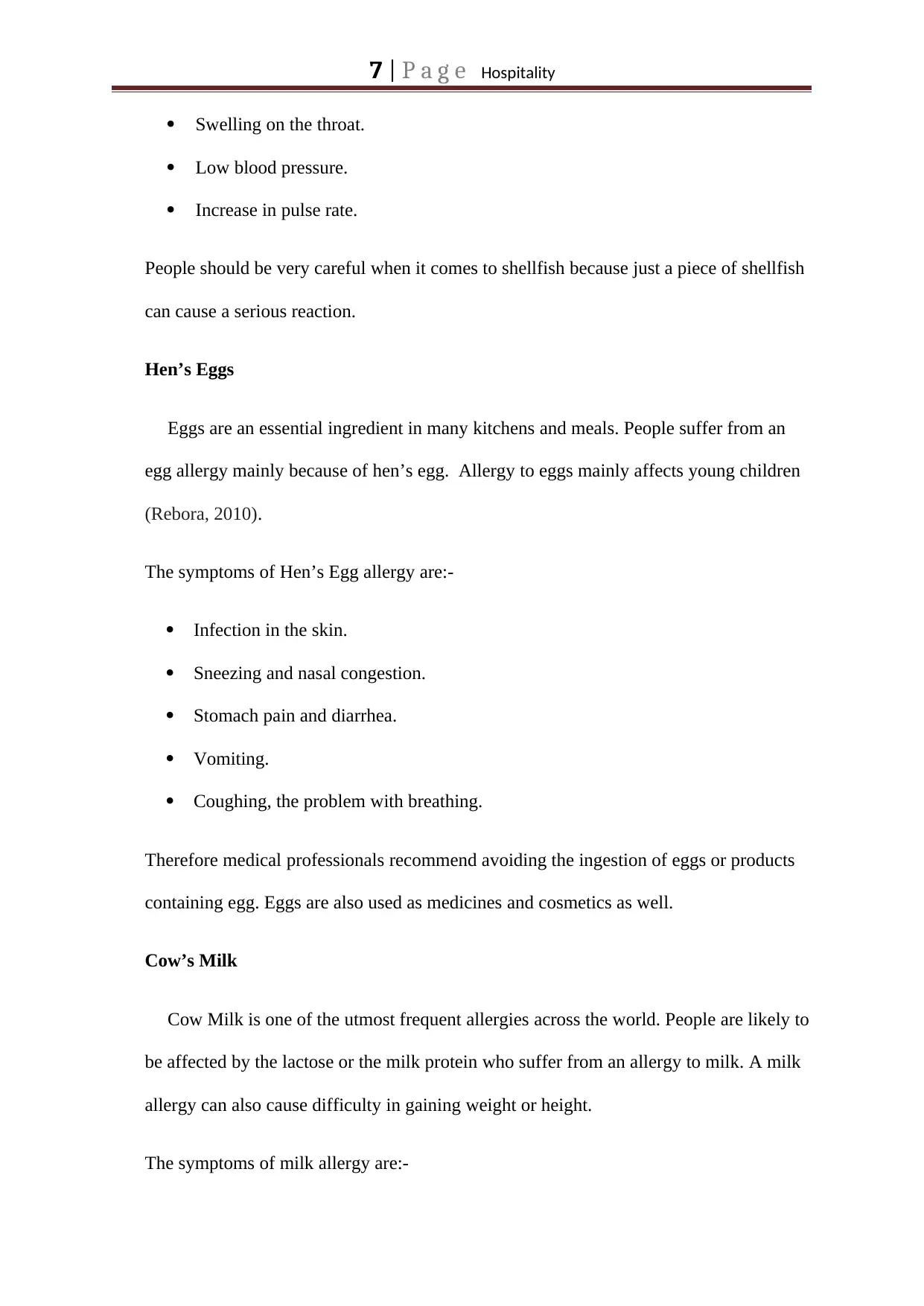
7 | P a g e Hospitality
Swelling on the throat.
Low blood pressure.
Increase in pulse rate.
People should be very careful when it comes to shellfish because just a piece of shellfish
can cause a serious reaction.
Hen’s Eggs
Eggs are an essential ingredient in many kitchens and meals. People suffer from an
egg allergy mainly because of hen’s egg. Allergy to eggs mainly affects young children
(Rebora, 2010).
The symptoms of Hen’s Egg allergy are:-
Infection in the skin.
Sneezing and nasal congestion.
Stomach pain and diarrhea.
Vomiting.
Coughing, the problem with breathing.
Therefore medical professionals recommend avoiding the ingestion of eggs or products
containing egg. Eggs are also used as medicines and cosmetics as well.
Cow’s Milk
Cow Milk is one of the utmost frequent allergies across the world. People are likely to
be affected by the lactose or the milk protein who suffer from an allergy to milk. A milk
allergy can also cause difficulty in gaining weight or height.
The symptoms of milk allergy are:-
Swelling on the throat.
Low blood pressure.
Increase in pulse rate.
People should be very careful when it comes to shellfish because just a piece of shellfish
can cause a serious reaction.
Hen’s Eggs
Eggs are an essential ingredient in many kitchens and meals. People suffer from an
egg allergy mainly because of hen’s egg. Allergy to eggs mainly affects young children
(Rebora, 2010).
The symptoms of Hen’s Egg allergy are:-
Infection in the skin.
Sneezing and nasal congestion.
Stomach pain and diarrhea.
Vomiting.
Coughing, the problem with breathing.
Therefore medical professionals recommend avoiding the ingestion of eggs or products
containing egg. Eggs are also used as medicines and cosmetics as well.
Cow’s Milk
Cow Milk is one of the utmost frequent allergies across the world. People are likely to
be affected by the lactose or the milk protein who suffer from an allergy to milk. A milk
allergy can also cause difficulty in gaining weight or height.
The symptoms of milk allergy are:-
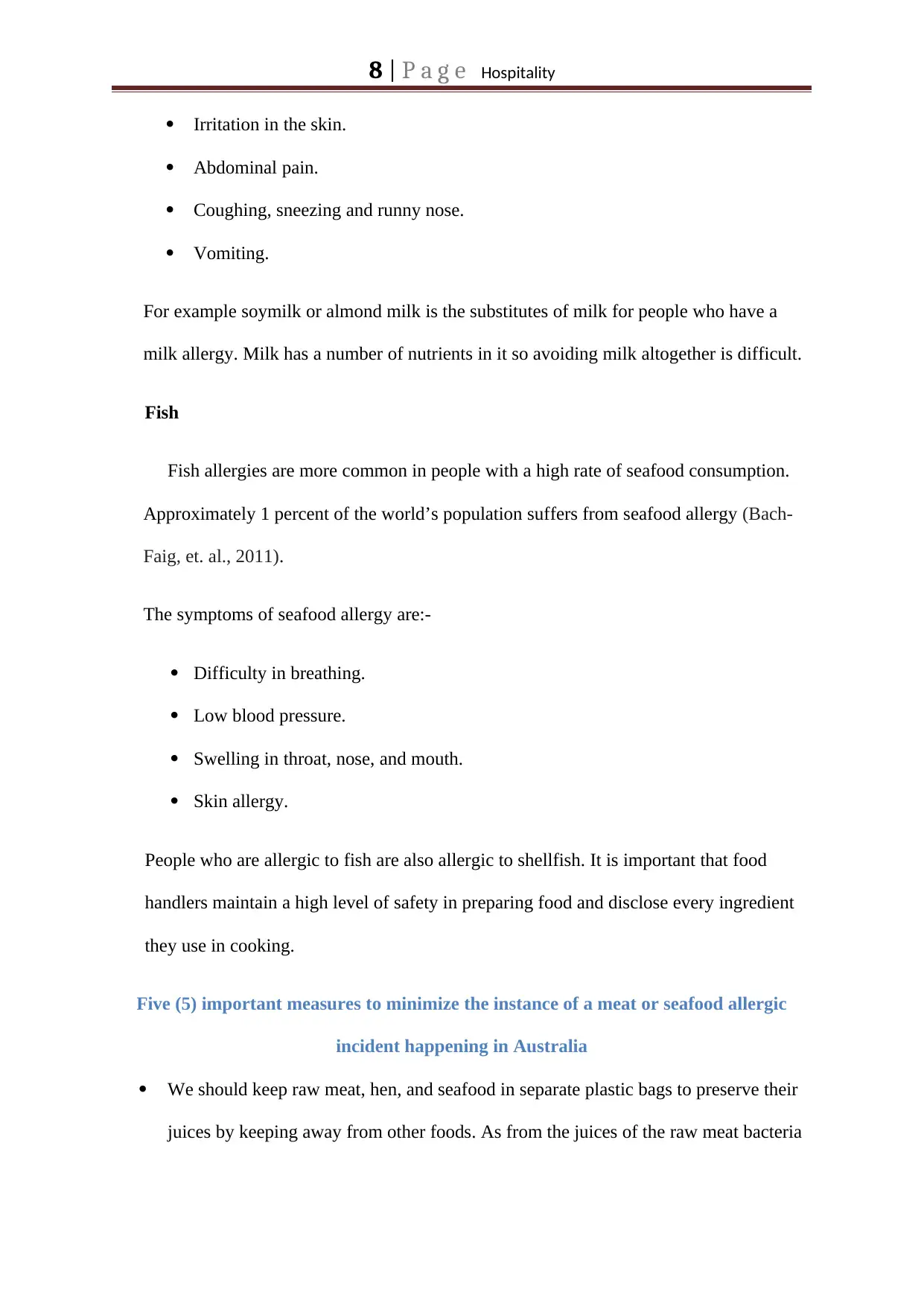
8 | P a g e Hospitality
Irritation in the skin.
Abdominal pain.
Coughing, sneezing and runny nose.
Vomiting.
For example soymilk or almond milk is the substitutes of milk for people who have a
milk allergy. Milk has a number of nutrients in it so avoiding milk altogether is difficult.
Fish
Fish allergies are more common in people with a high rate of seafood consumption.
Approximately 1 percent of the world’s population suffers from seafood allergy (Bach-
Faig, et. al., 2011).
The symptoms of seafood allergy are:-
Difficulty in breathing.
Low blood pressure.
Swelling in throat, nose, and mouth.
Skin allergy.
People who are allergic to fish are also allergic to shellfish. It is important that food
handlers maintain a high level of safety in preparing food and disclose every ingredient
they use in cooking.
Five (5) important measures to minimize the instance of a meat or seafood allergic
incident happening in Australia
We should keep raw meat, hen, and seafood in separate plastic bags to preserve their
juices by keeping away from other foods. As from the juices of the raw meat bacteria
Irritation in the skin.
Abdominal pain.
Coughing, sneezing and runny nose.
Vomiting.
For example soymilk or almond milk is the substitutes of milk for people who have a
milk allergy. Milk has a number of nutrients in it so avoiding milk altogether is difficult.
Fish
Fish allergies are more common in people with a high rate of seafood consumption.
Approximately 1 percent of the world’s population suffers from seafood allergy (Bach-
Faig, et. al., 2011).
The symptoms of seafood allergy are:-
Difficulty in breathing.
Low blood pressure.
Swelling in throat, nose, and mouth.
Skin allergy.
People who are allergic to fish are also allergic to shellfish. It is important that food
handlers maintain a high level of safety in preparing food and disclose every ingredient
they use in cooking.
Five (5) important measures to minimize the instance of a meat or seafood allergic
incident happening in Australia
We should keep raw meat, hen, and seafood in separate plastic bags to preserve their
juices by keeping away from other foods. As from the juices of the raw meat bacteria
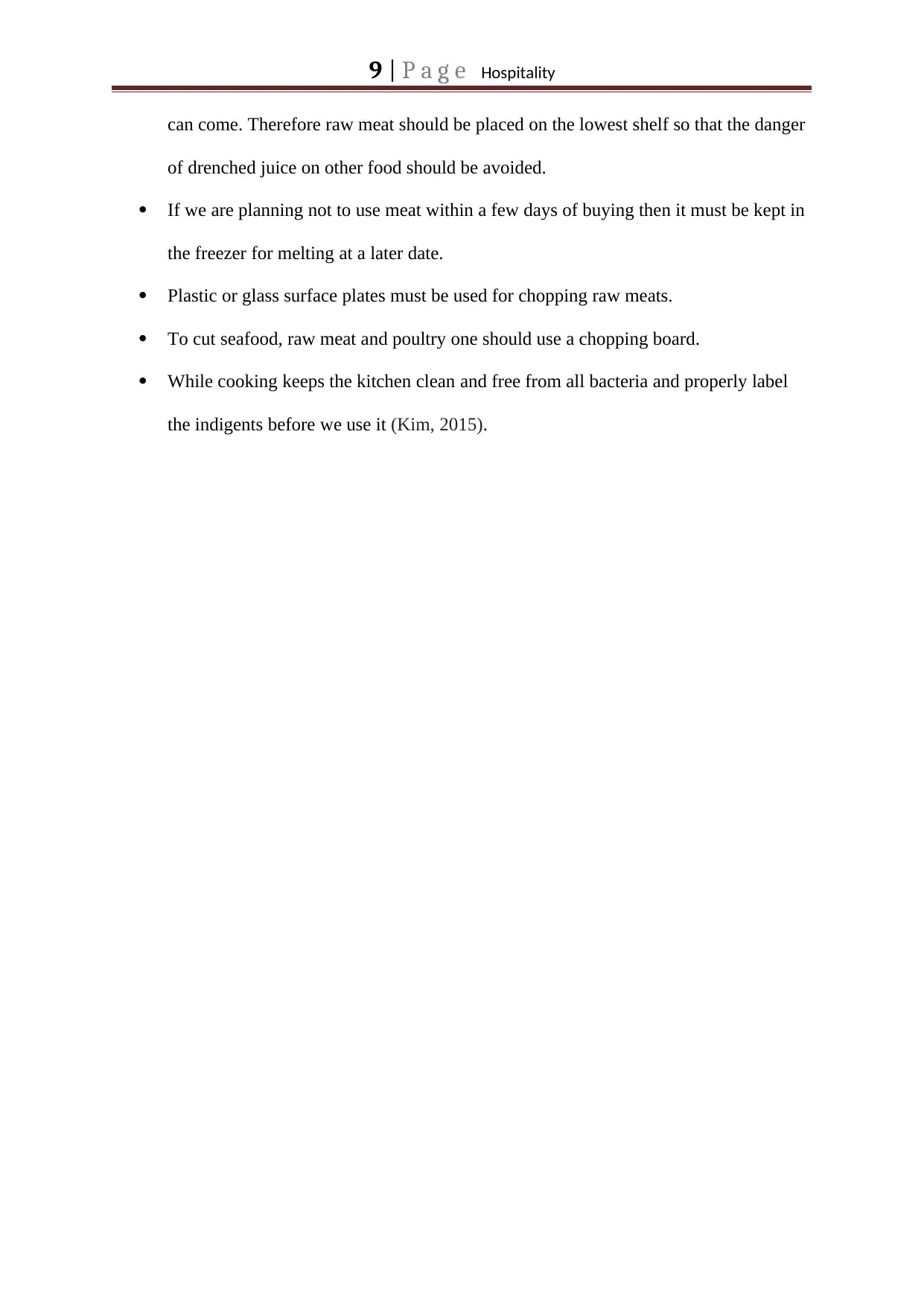
9 | P a g e Hospitality
can come. Therefore raw meat should be placed on the lowest shelf so that the danger
of drenched juice on other food should be avoided.
If we are planning not to use meat within a few days of buying then it must be kept in
the freezer for melting at a later date.
Plastic or glass surface plates must be used for chopping raw meats.
To cut seafood, raw meat and poultry one should use a chopping board.
While cooking keeps the kitchen clean and free from all bacteria and properly label
the indigents before we use it (Kim, 2015).
can come. Therefore raw meat should be placed on the lowest shelf so that the danger
of drenched juice on other food should be avoided.
If we are planning not to use meat within a few days of buying then it must be kept in
the freezer for melting at a later date.
Plastic or glass surface plates must be used for chopping raw meats.
To cut seafood, raw meat and poultry one should use a chopping board.
While cooking keeps the kitchen clean and free from all bacteria and properly label
the indigents before we use it (Kim, 2015).
Paraphrase This Document
Need a fresh take? Get an instant paraphrase of this document with our AI Paraphraser
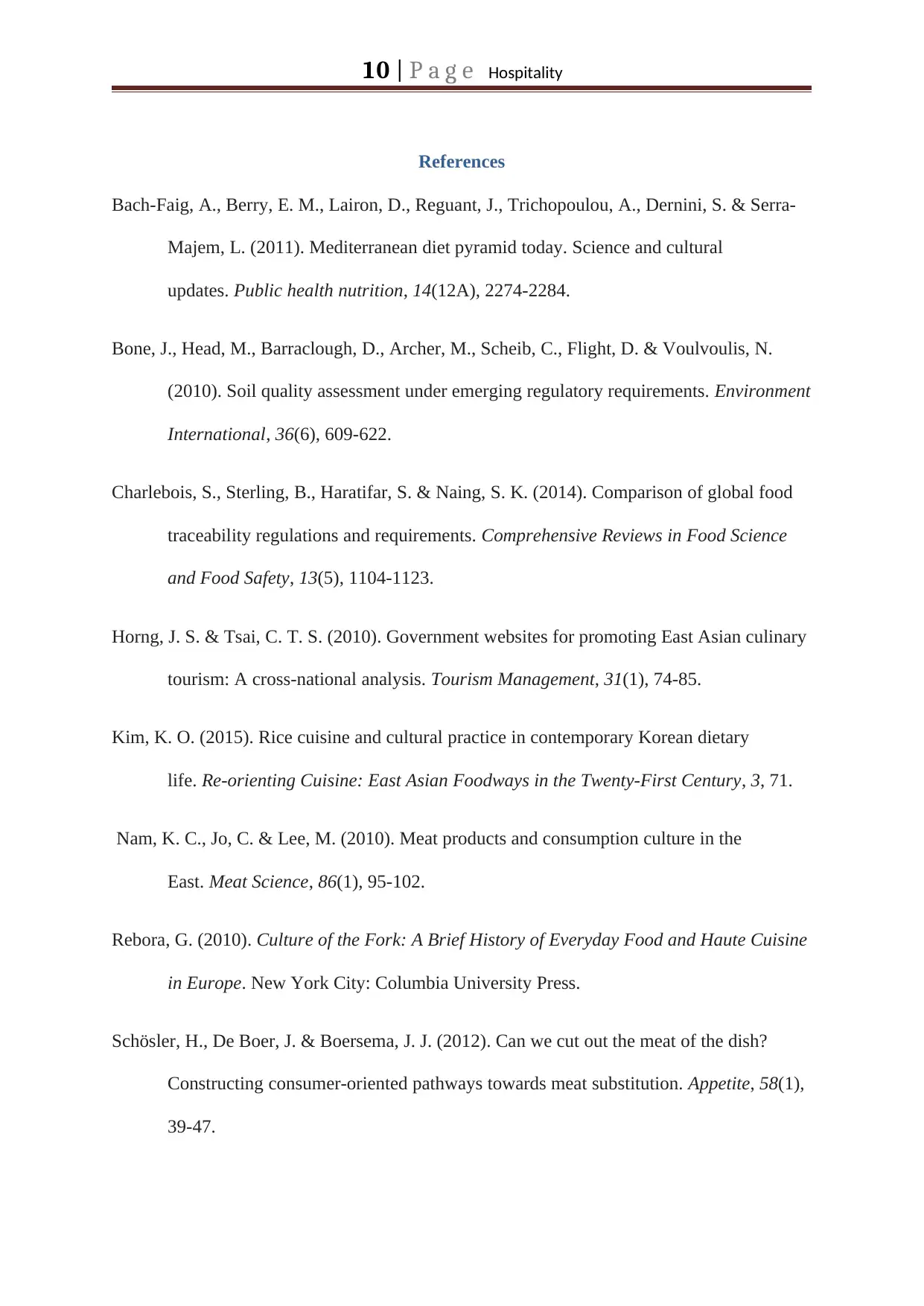
10 | P a g e Hospitality
References
Bach-Faig, A., Berry, E. M., Lairon, D., Reguant, J., Trichopoulou, A., Dernini, S. & Serra-
Majem, L. (2011). Mediterranean diet pyramid today. Science and cultural
updates. Public health nutrition, 14(12A), 2274-2284.
Bone, J., Head, M., Barraclough, D., Archer, M., Scheib, C., Flight, D. & Voulvoulis, N.
(2010). Soil quality assessment under emerging regulatory requirements. Environment
International, 36(6), 609-622.
Charlebois, S., Sterling, B., Haratifar, S. & Naing, S. K. (2014). Comparison of global food
traceability regulations and requirements. Comprehensive Reviews in Food Science
and Food Safety, 13(5), 1104-1123.
Horng, J. S. & Tsai, C. T. S. (2010). Government websites for promoting East Asian culinary
tourism: A cross-national analysis. Tourism Management, 31(1), 74-85.
Kim, K. O. (2015). Rice cuisine and cultural practice in contemporary Korean dietary
life. Re-orienting Cuisine: East Asian Foodways in the Twenty-First Century, 3, 71.
Nam, K. C., Jo, C. & Lee, M. (2010). Meat products and consumption culture in the
East. Meat Science, 86(1), 95-102.
Rebora, G. (2010). Culture of the Fork: A Brief History of Everyday Food and Haute Cuisine
in Europe. New York City: Columbia University Press.
Schösler, H., De Boer, J. & Boersema, J. J. (2012). Can we cut out the meat of the dish?
Constructing consumer-oriented pathways towards meat substitution. Appetite, 58(1),
39-47.
References
Bach-Faig, A., Berry, E. M., Lairon, D., Reguant, J., Trichopoulou, A., Dernini, S. & Serra-
Majem, L. (2011). Mediterranean diet pyramid today. Science and cultural
updates. Public health nutrition, 14(12A), 2274-2284.
Bone, J., Head, M., Barraclough, D., Archer, M., Scheib, C., Flight, D. & Voulvoulis, N.
(2010). Soil quality assessment under emerging regulatory requirements. Environment
International, 36(6), 609-622.
Charlebois, S., Sterling, B., Haratifar, S. & Naing, S. K. (2014). Comparison of global food
traceability regulations and requirements. Comprehensive Reviews in Food Science
and Food Safety, 13(5), 1104-1123.
Horng, J. S. & Tsai, C. T. S. (2010). Government websites for promoting East Asian culinary
tourism: A cross-national analysis. Tourism Management, 31(1), 74-85.
Kim, K. O. (2015). Rice cuisine and cultural practice in contemporary Korean dietary
life. Re-orienting Cuisine: East Asian Foodways in the Twenty-First Century, 3, 71.
Nam, K. C., Jo, C. & Lee, M. (2010). Meat products and consumption culture in the
East. Meat Science, 86(1), 95-102.
Rebora, G. (2010). Culture of the Fork: A Brief History of Everyday Food and Haute Cuisine
in Europe. New York City: Columbia University Press.
Schösler, H., De Boer, J. & Boersema, J. J. (2012). Can we cut out the meat of the dish?
Constructing consumer-oriented pathways towards meat substitution. Appetite, 58(1),
39-47.
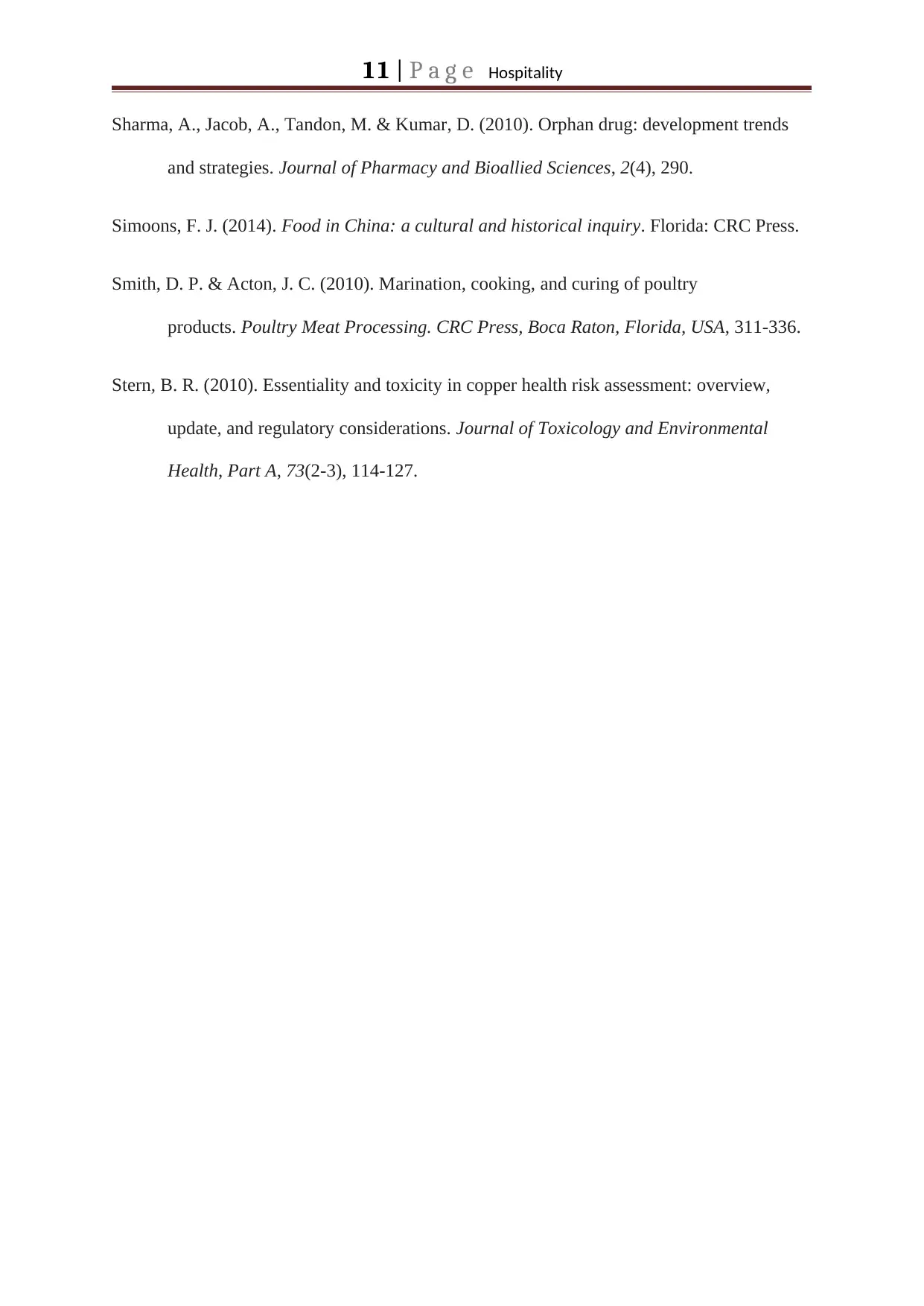
11 | P a g e Hospitality
Sharma, A., Jacob, A., Tandon, M. & Kumar, D. (2010). Orphan drug: development trends
and strategies. Journal of Pharmacy and Bioallied Sciences, 2(4), 290.
Simoons, F. J. (2014). Food in China: a cultural and historical inquiry. Florida: CRC Press.
Smith, D. P. & Acton, J. C. (2010). Marination, cooking, and curing of poultry
products. Poultry Meat Processing. CRC Press, Boca Raton, Florida, USA, 311-336.
Stern, B. R. (2010). Essentiality and toxicity in copper health risk assessment: overview,
update, and regulatory considerations. Journal of Toxicology and Environmental
Health, Part A, 73(2-3), 114-127.
Sharma, A., Jacob, A., Tandon, M. & Kumar, D. (2010). Orphan drug: development trends
and strategies. Journal of Pharmacy and Bioallied Sciences, 2(4), 290.
Simoons, F. J. (2014). Food in China: a cultural and historical inquiry. Florida: CRC Press.
Smith, D. P. & Acton, J. C. (2010). Marination, cooking, and curing of poultry
products. Poultry Meat Processing. CRC Press, Boca Raton, Florida, USA, 311-336.
Stern, B. R. (2010). Essentiality and toxicity in copper health risk assessment: overview,
update, and regulatory considerations. Journal of Toxicology and Environmental
Health, Part A, 73(2-3), 114-127.
1 out of 12
Your All-in-One AI-Powered Toolkit for Academic Success.
+13062052269
info@desklib.com
Available 24*7 on WhatsApp / Email
![[object Object]](/_next/static/media/star-bottom.7253800d.svg)
Unlock your academic potential
© 2024 | Zucol Services PVT LTD | All rights reserved.


